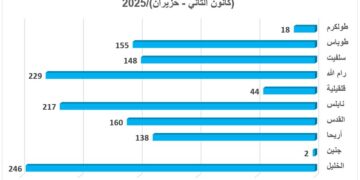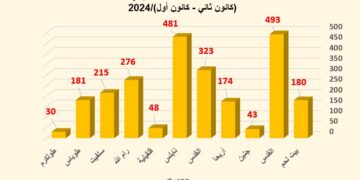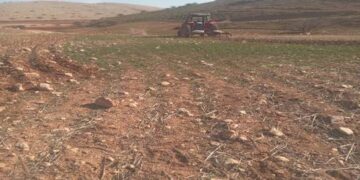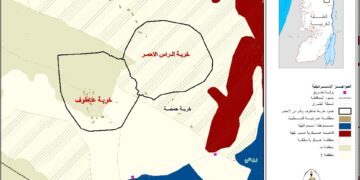- Violation: settlers’ attacks.
- Location: Wadi Qana area, west of Derstia town / Salfit governorate.
- Date of violation: 04/19/2022.
- The aggressor: a group of settlers.
- The affected party: farmer Jihad Khaled Mansour.
- Details of the violation:
At the beginning of the early evening hours of Tuesday, the nineteenth of April 2022, an extremist group of settlers stormed the Ain al-Bassa area, located in the heart of Wadi Qana, west of the town of Derstia. A group of nine settlers deliberately raided a rural house owned by the family of farmer Jihad Khaled Mansour (49 years), from the town of Derstia. The settlers deliberately caused damage to the house and sabotaged its basic possessions. According to the field follow-up, the damages are as the following:
- Sabotage of three solar cells and their network, which is used to provide electricity.
- Cutting the water lines that supply the land adjacent to the house with irrigation water. The length of these lines is 34 meters with a diameter of a quarter of an inch.
- Destruction by a knife of a water tank with a capacity of (1.5 m³), which was on the roof of the house.
- breaking the glass of a window in the house.
Farmer Jihad Mansour told the field researcher of the Land Research Center the following:
“This attack is not new, as previously, four years ago, I renovated parts of the house, but the occupation, through the so-called Organization Department, the occupation inspector handed me an order to stop construction on the pretext of not having a permit (license), and after a while parts of the house were demolished, and also the settlers cut down a number of the grapes and olives that I have planted several times in a row, and despite this, I insist on staying despite the occupation”.
It is reported that the farmer Jihad Mansour supports a family of nine members (5 males and 4 females), including 3 children.
 |
 |
 |
It is noteworthy that the Wadi Qana area, over the past years, has witnessed significant targeting by the settlers and also by the Israeli Civil Administration and its various branches, to the extent that the presence of farmers there is fraught with danger. Moreover, extensive demolitions and complete destruction of a number of agricultural development projects implemented there by a number of local and international agricultural organizations were previously monitored by the field researcher.
About Wad Qana:[1]
Wadi Qana is located in the northwest part of Deir Istya and surrounded by: Jeindafout, Kfar Laqif and Azoun from the east, Sinrya and Kfar Thulth form the west, Qarawat Bani Hassan from the south, and Amatin and Deir Istya from the east. Most of Wadi Qana lands are owned by farmers from Deir Istya. Wad Qana has a total area of 10 thousand dunums and contains 11 water springs , most of Wad Qana lands are planted with oranges and olives.
Colonies ibn Wad Qana:
|
# |
Settlement name |
Establishment year |
(built-up) area |
Total area of control |
Number of settlers until 2004 |
|
1 |
Karnei Shomron |
1978 |
1351 |
7339 |
6170 |
|
2 |
Ma’ale Shomron |
1980 |
216 |
1903 |
549 |
|
3 |
Yakir |
1881 |
342 |
1364 |
960 |
|
4 |
Immanuel |
1982 |
328 |
1909 |
2585 |
|
5 |
Ginat Shomron |
1985 |
484 |
N.A |
N.A |
|
6 |
Nofim |
1989 |
248 |
331 |
414 |
|
7 |
Nof Ornim |
1991 |
153 |
N.A |
N.A |
|
Total |
3122 |
1746 |
10678 |
||
Source: GIS Unit – Land Research Center.
[1] GIS-LRC
The Land Research Center
LRC












